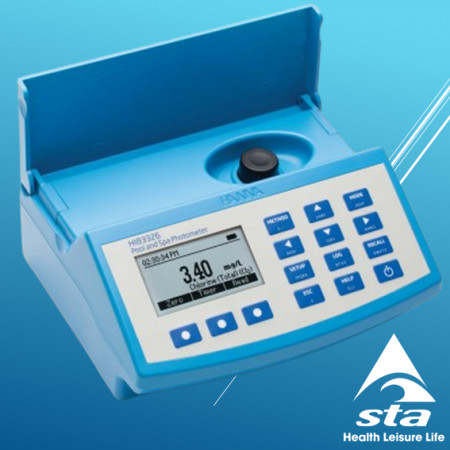Multi-Parameter photometer for Alkalinity, Bromine, Chlorine, Copper, Cyanuric Acid, Calcium Hardness, Iron, Nitrate, Ozone, pH, phosphate with optional pH electrode

Multi-Parameter photometer for Alkalinity, Bromine, Chlorine, Copper, Cyanuric Acid, Calcium Hardness, Iron, Nitrate, Ozone, pH, phosphate with optional pH electrode
Professional Pool & Spa Meters
Description
HI-83326 Pool and Spa Photometer with pH
Advanced optical system - Unparalleled performance from a benchtop photometer.
One meter can be used for both photometric and pH measurements. HI-83326 is a compact, multi-parameter photometer for use in pool and spa applications. The meter is one of the most advanced photometers available with an innovative optical design which utilises a reference detector and focusing lens to eliminate errors from changes in the light source and from imperfections in the glass cuvette.
The HI-83326 has 12 different programmed methods measuring 11 key water quality parameters and also offers an absorbance measurement mode for performance verification and for users who would like to develop their own concentration versus absorbance curves.
Pool and spa parameters include free chlorine, alkalinity, nitrite, and phosphate which are critical to maintaining a healthy system.
To save valuable laboratory benchtop space, the HI-83326 doubles as a professional pH meter with its digital pH/temperature electrode input. Now one meter can be used for both photometric and pH measurements.
Made with the pool and spa industry in mind, a basic necessity of pool water treatment is to maintain the water in a safe and pleasant condition for the swimmers. In pool and spa water treatment, disinfection is essential to rid the pool of bacteria and control nuisance organisms like algae which may occur in the pool, spa, filtration equipment, or piping. There are a number of available disinfectant compounds including chlorine, bromine, and ozone. In order to achieve ideal water conditions, water requires testing on a daily and sometimes hourly basis to ensure there is enough residual disinfectant and to maintain pH levels. Equally important is calcium hardness and alkalinity; these levels should be monitored weekly to ensure the pool or spa water is well balanced to avoid corrosion and scale formation.
A digital pH electrode input allows the user to measure pH by a traditional glass electrode.
The HI-83326 offers an absorbance measuring mode that allows for CAL Check standards to be used to validate the performance of the system. The absorbance mode allows the user to select one of the three wavelengths of light (525 nm, 575 nm, and 610 nm) to measure and plot their own concentration versus absorbance mode. This is useful for users with their own chemical method and for educators to teach the concept of absorbance by using the Beer-Lambert Law.
Two USB ports are provided for transferring data to a flash drive or computer and to use as a power source for the meter. For added convenience and portability the meter can also operate on an internal 3.7 VDC Lithium-polymer rechargeable battery.
Key features:
- Advanced optical system with brighter, long-lasting LED light source
- Backlit 128 x 64 Pixel Graphic Liquid Crystal Display
- Built-in Reaction Timer for Photometric Measurements
- Absorbance mode - concentration versus absorbance
- Units of Measurement plus chemical form displayed
- Result conversion at the touch of a button
- Cuvette cover
- pH and temperature measurement with a single digital probe
- Good Laboratory Practice (GLP) - track calibration information including date, time, buffers used, offset and slope for traceability
- CAL Check alerts user to potential problems during the calibration process
- Data Logging - Up to 1000 photometric and pH readings can be stored.
- Logged readings can be quickly and easily transferred to a flash drive or to a PC. Data is exported as a .CSV file for use with spreadsheet programs.
- Battery Status Indicator
- Error Messages
High Efficiency LED Light Source
An LED light source offers superior performance compared to a tungsten lamp. LEDs have a much higher luminous efficiency, providing more light while using less power. They also produce very little heat, which could otherwise affect the optical components and electronic stability. LEDs are available in a wide array of wavelengths, whereas tungsten lamps are supposed to be white light (all wavelengths of visible light) but actually have a poor blue/violet light output.
High Quality Narrow Band Interference Filters
The narrow band interference filter not only ensure greater wavelength accuracy (+/- 1 nm) but are extremely efficient. The filters used allow up to 95% of the light from the LED to be transmitted as compared to other filters that are only 75% efficient. The higher efficiency allows for a brighter, stronger light source. The end result is higher measurement stability and less wavelength error.
Reference Detector for a Stable Light Source
A beam splitter is used as part of the internal reference system of the HI-83300 photometer. The reference detector compensates for any drift due to power fluctuations or ambient temperature changes. Now you can rely on a stable source of light between your blank (zero) measurement and sample measurement.
Large Cuvette Size
The sample cell of the HI-83308 fits a round, glass cuvette with a 25 mm path length. Along with the advanced optical components, the larger size of the cuvette greatly reduces errors in rotation from the indexing mark of the cuvettes. The relatively long path length of the sample cuvette allows the light to pass through more of the sample solution, ensuring accurate measurements even in low absorbance samples.
Focusing Lens for Greater Light Yield
Adding a focusing lens to the optical path allows for the collection of all of the light that exits the cuvette and focusing the light on the silicon photo detector. This novel approach to photometric measurements cancels the errors from imperfections and scratches present in the glass cuvette eliminating the need to index the cuvette.
Input Channels1 pH electrode input and 3 photometer wavelengths